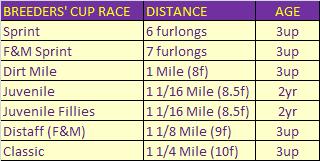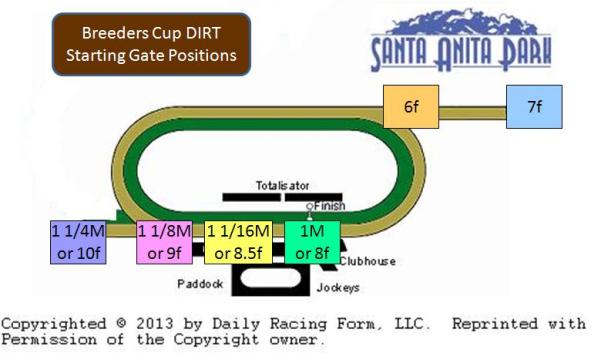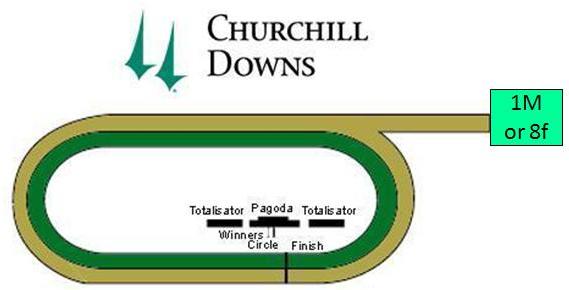Breeders’ Cup 2014 – Navigating The Santa Anita Dirt Track
In a prior article we provided an overview of Santa Anita turf course and how it’s unique configuration might impact the running of Breeders’ Cup races in 2014. Click here to read that article.
In this article we are going to cover the Santa Anita dirt track, and although it isn’t quite as unique as the turf course, there are still factors to consider for each distance run in the Breeders’ Cup races.
For example, where is the starting gate position for each race? How close is it to the first turn? Is there an advantage to inside or outside post positions at each distance? How does the Santa Anita track layout compare to other racetracks?
To the right is a table listing the Breeders’ Cup dirt races that will be contested at the various distances. You can see that other than the two Juvenile races, every other distance is only run once for Breeders’ Cup races.
For some distances, the location of the starting gate is very similar to other racetracks. For other distances, it is much different … even when the size of the oval (1 mile) is identical to that of Santa Anita.
Below is a diagram of the dirt track, with the starting gate positions labeled (in colored boxes) for each of the distances.
The two sprint races (6 and 7 furlongs) start on the backside, with the starting gate position for the 7-furlong race coming out of a chute. This is very similar to other racetracks. At the 7-furlong distance, horses have the entire length of the backstretch to get into position before having to make their first (and only) turn. This makes the outside post position a non-issue, and in fact sometimes an advantage for horses that prefer to run “uncovered.” This term is often used by trainers, and refers to horses that do their best running from the outside of the pack. These horses can let the frontrunners vie for the lead, while settling in behind them, usually in a favorable position flanking the horses caught inside.
On the flip side, a horse stuck in an inside post-position and lacking quality tactical speed, might get caught inside by other horses passing him down the long straight run. This has been the doom of many horses in 7-furlong races. An excellent example of this can be found in the 2011 Breeders’ Cup Filly & Mare Sprint. The 7-5 favorite, Turbulent Descent was forced to break from post position #3. Below is a replay of the race, she is #3 with the yellow silks and cap. The overhead view gives a great perspective of her early race position.
She did not break well, was pinched back, moved up too quickly, had to check, was forced to go wide into the lane, and despite taking the lead in the stretch, she simply ran out of gas in the latter stages of the race. Turbulent Descent was a quality filly who went on to win the Grade 1 Ballerina as a 3-year old. But in her Breeders’ Cup race, I do believe she was a victim of post position and a bad break. Unfortunately, for horses caught inside in a 7-furlong race, it can be very difficult to overcome problems like this early in the race.
Next let’s consider the 1-mile (8 furlong) distance. Here is a distance where the starting gate position varies sharply from other racetracks. As you can see in the above diagram, the starting gate at Santa Anita is located exactly on the finish line. However, for many other racetracks, the starting gate location is located in a chute (similar to 7-furlongs) on the far right hand corner. For example, below is a diagram of Churchill Downs, with the starting gate location for 1-mile shown.
So, despite Churchill Downs being the exact same size oval (1-mile) as Santa Anita, due to their elongated chute, these races are run much differently at the two tracks. At Churchill, the same scenario described above for 7-furlongs plays out. However, at Santa Anita, where the gate is located only a few hops from the first turn, the inside post position is helpful to almost any horse, and greatly advantageous to a horse with fast-breaking early speed. On the other hand, an outside post position in the same situation is a serious disadvantage. Even if the horse has enough speed to run up to the front before the first turn, he must use some energy to get there, which could compromise his chances later.
If he cannot get to the front by the first turn, then he risks losing precious ground to the field by going wide around the turn, and potentially the 2nd turn as well. He could end up running substantially more distance than the other horses located to his inside. With that said, of course there are exceptions to any rule. And, in 2013, despite breaking from an outside post position, Goldencents raced to the early lead and went on to win the race. If you watch the first few moments of the video replay below, you will appreciate the effort it took to obtain that early lead. Goldencents is #12 in the light blue silks and cap.
In the end, Goldencents was able to overcome that tough post position, but if you can imagine a break that didn’t go so well, or if there were multiple horses inside of him with equivalent speed, it’s very possible he could have been spun wide into the first turn, and who knows what happens from there? Another scenario to consider – let’s say Goldencents had an inside post position. Just think how much separation he would have gotten from the pack early in the race. He might have won the race by five lengths in that circumstance.
Next we’ll review the two races contested at 11/16 mile (8.5f), which happen to be the two Juvenile races for 2-year old horses. At this distance, Santa Anita races are contested in nearly the exact same manner as other 1-mile ovals like Churchill Downs and Monmouth Park, 2-turn races that begin around mid-stretch. Since they are so similar, we looked at the results for the past eight Breeders’ Cup races, which happen to represent only these three racetracks. Below is a chart showing the results (by post position) of Juvenile and Juvenile Fillies races combined.
You can see that In-The-Money finishers were equally distributed throughout their post positions. However, when it comes to actual winners, there were only two winners out of a total of 48 starters in post positions 10 or higher. This seems reasonable given the potential traffic difficulties that a horse has to overcome starting from these widest of post positions.
Here is the Santa Anita track diagram repeated from above for easy reference.
Continuing on to the 11/8 mile (9f) distance, where the only Breeders’ Cup race is the Distaff for Fillies and Mares. Similar to the races run at 11/16 mile, this distance is very similar to other racetracks, with the exception of Belmont Park due to it’s massive oval. Click here to read an article on Belmont Park.
While it can be compared to other tracks, the nature of the Distaff race makes it hard to find anything useful in prior Breeders’ Cup trends when it comes to post positions. In recent years, field sizes have been reduced to an average of just eight runners in the past six years. This fact combined with some recent superstars (e.g. Beholder, Royal Delta, and Zenyatta) dominating at short prices have made it a somewhat predictable race. If these circumstances repeat this year, we suggest not placing much emphasis on post position for this race.
Finally, we will consider the Breeders’ Cup Classic, contended at the distance of 11/4 mile (10f). As you can see from the diagram, the starting gate is placed in a small chute just prior to the stretch run at Santa Anita. This location provides the horses with adequate opportunity to gain position before they hit the first turn. This configuration is very similar to what you find at other Breeders’ Cup venues. So we went searching for trends relative to post position, and alas we came up with very little. The chart below shows the results for the past ten years.
The best you can say is there does seem to be a sweet spot in that 4-6 post position, with half the winners coming from there and a corresponding number finishing in-the-money. While it might be hard to make a selection on this fact alone, it could strengthen a play if you have a horse of choice that lands in that post position.
As we were reviewing the Classic charts, one tidbit of information was uncovered. Of the last ten winners of the Breeders’ Cup Classic, six had their final prep race at Belmont Park.
In closing, we’d like to emphasize that rarely should a selection be based solely on post position and location of the starting gate. But, it’s good information to keep in mind when you’re evaluating the value of a horse. The general betting public is often enamored with speed figures, trainers, jockeys, etc. They also tend to overlook matters of post position and starting gate location, figuring that a great horse will overcome those factors. While that is true, sometimes … the obstacles they must overcome can equalize the playing field in these highly competitive events. The above example of Turbulent Descent demonstrates that quite well.
Why settle for a short priced horse that is forced to overcome obstacles, when you can identify a decently priced horse that has the best of circumstances (e.g. good speed and an inside post position at the 1-mile distance)?
Best of luck.
![]()
By Neal Benoit
* * * WE’D LIKE TO HEAR FROM YOU. PLEASE CLICK HERE TO TAKE OUR READER SURVEY. * * *








5 comments on “Breeders’ Cup 2014 – Navigating The Santa Anita Dirt Track”